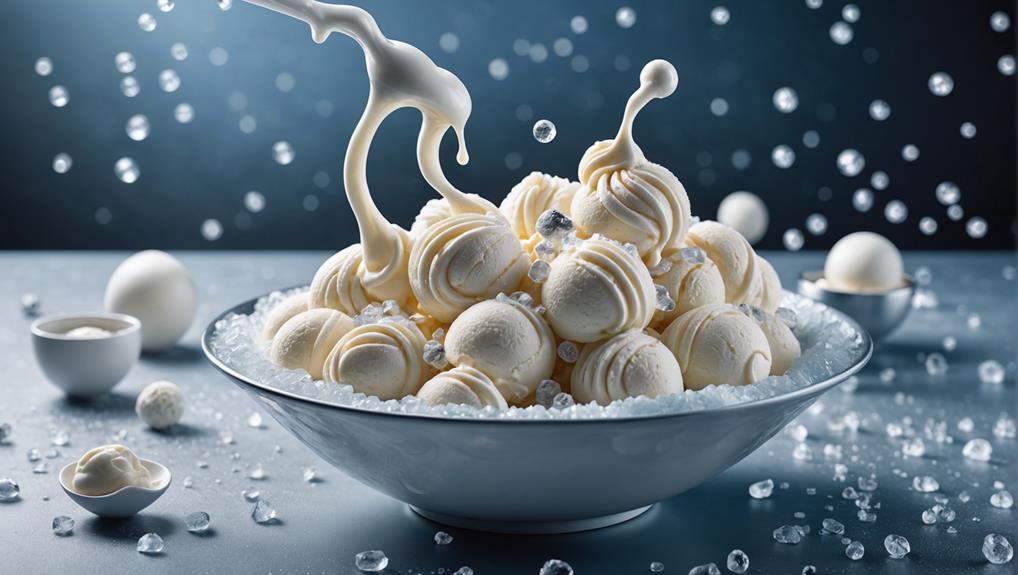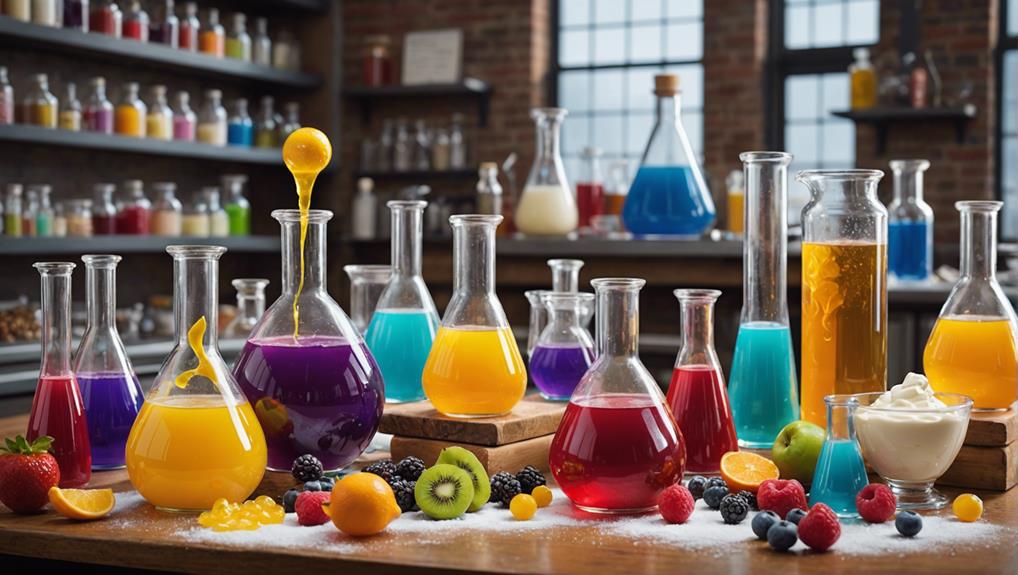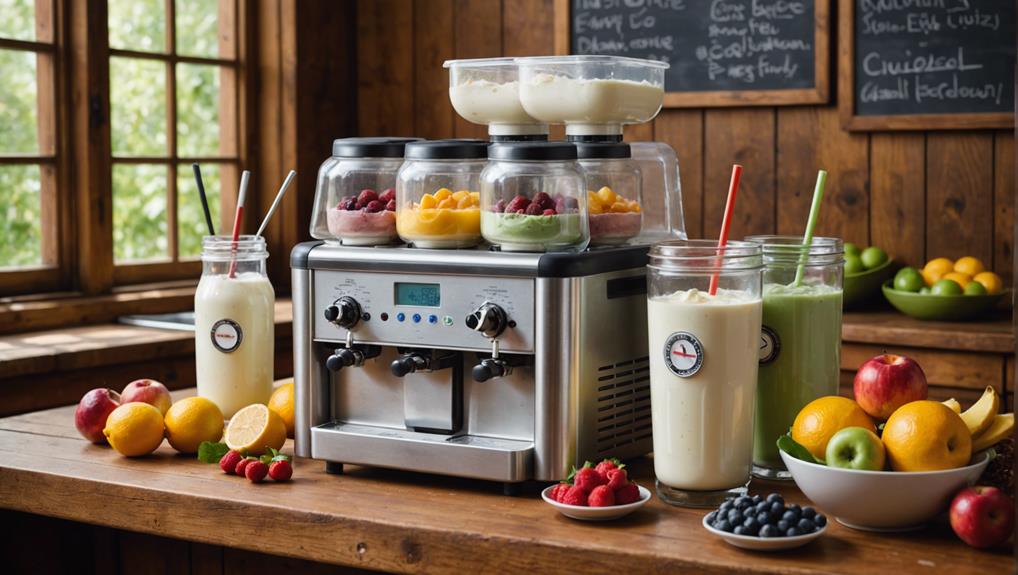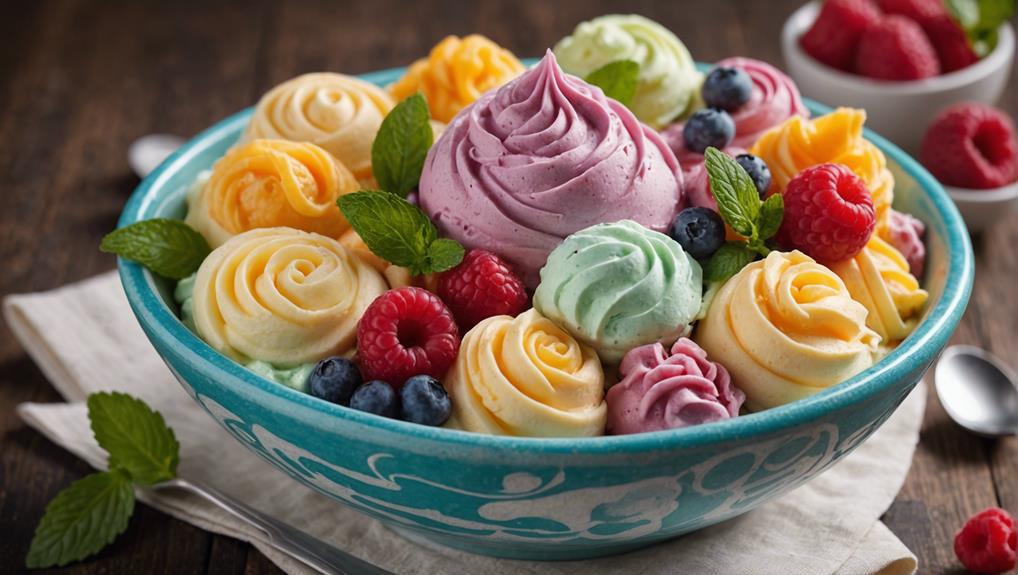Frozen yogurt's chemistry intricately involves several components. Milk proteins like casein and whey shape its texture and consistency. Live bacterial cultures, including Lactobacillus bulgaricus and Streptococcus thermophilus, drive fermentation, providing not only the distinct taste but significant probiotic health benefits. Precise temperature and ingredient control during fermentation and freezing optimize texture and flavor through controlled lactic acid production and minimal ice crystal formation. Sweeteners, stabilizers, and emulsifiers like sorbitol and stevia further enhance sensory appeal and product stability. The selection and interaction of these elements dictate the final product's quality and consumer acceptance, underscoring the complexity behind frozen yogurt's creation.
Key Takeaways
- Casein and whey proteins form a gel-like network and stabilize the matrix for smooth texture and creaminess.
- Live bacterial cultures like Lactobacillus bulgaricus and Streptococcus thermophilus ferment lactose, providing health benefits and enhancing flavor.
- Sweeteners and flavorings balance taste and texture, influencing consumer perception and product distinctiveness.
- Stabilizers and emulsifiers prevent ice crystal growth, maintain texture, and ensure creaminess in frozen yogurt.
- Precise freezing techniques preserve probiotic benefits and control ice crystal size, affecting texture and stability.
Milk Proteins and Their Role

Milk proteins, particularly casein and whey, play a pivotal role in determining the texture and structural integrity of frozen yogurt. Casein proteins, when subjected to freezing conditions, form a gel-like network that enhances the smoothness and consistency of the final product. This gelation process is essential for maintaining an even texture, preventing the formation of large ice crystals that could otherwise degrade the quality of the frozen yogurt.
Whey proteins, on the other hand, contribute to the stabilization of the frozen matrix by interacting with water molecules and other components within the mixture. This interaction is crucial for inhibiting ice crystal growth, ensuring a creamier texture and prolonging the shelf life of the product. The precise ratio of casein to whey proteins is important in achieving the desired mouthfeel and structural integrity. An ideal balance between these milk proteins can significantly impact the sensory attributes of frozen yogurt, making it smoother and more enjoyable to consume.
Understanding the intricate interactions between casein proteins and whey proteins is essential for food scientists aiming to develop high-quality frozen yogurt. By manipulating these protein interactions, manufacturers can fine-tune the textural properties, thereby enhancing the overall consumer experience.
Live Bacterial Cultures
Live bacterial cultures, including Lactobacillus bulgaricus and Streptococcus thermophilus, play a vital role in the fermentation process of frozen yogurt, converting lactose into lactic acid and contributing to its tangy flavor profile. These probiotics not only differentiate frozen yogurt from traditional ice cream but also offer significant health benefits, such as enhanced digestive function and immune support. Adherence to standards set by the National Yogurt Association guarantees that frozen yogurt contains sufficient levels of live and active cultures to provide these probiotic advantages.
Health Benefits Explained
The health benefits of frozen yogurt are largely attributed to its live bacterial cultures, which are known to support gut health and enhance overall well-being. These live active cultures, often referred to as probiotic cultures, are integral to the functional properties of frozen yogurt. Probiotic cultures such as Lactobacillus and Bifidobacterium species play a pivotal role in maintaining a balanced intestinal microbiota, thereby aiding in digestion and nutrient absorption.
The concentration of probiotics in frozen yogurt can vary, depending on the initial yogurt base and the specific strains used during production. Notably, controlled manufacturing processes can sometimes result in frozen yogurts that are more robust sources of probiotics compared to regular yogurts. This variability underscores the importance of adhering to standards set by regulatory bodies, such as the National Yogurt Association, which stipulates minimum thresholds for live active cultures to safeguard the health benefits of the final product.
Regular consumption of frozen yogurt containing these live cultures can contribute to a healthier gut environment. This, in turn, can enhance immune function, reduce gastrointestinal disturbances, and potentially mitigate the effects of lactose intolerance, thereby promoting overall physiological health.
Fermentation Process Steps
Initiating the fermentation process requires precise control of temperature and time to allow bacterial cultures such as Lactobacillus bulgaricus and Streptococcus thermophilus to effectively convert lactose into lactic acid. This biochemical transformation is fundamental in developing the characteristic tangy flavor and creamy texture of frozen yogurt. The fermentation process begins by introducing live bacterial cultures into pasteurized milk, which is maintained at an ideal temperature range of 40-45°C (104-113°F) to foster microbial activity.
During this controlled environment, the live bacterial cultures metabolize lactose, resulting in the production of lactic acid. This acidification process not only enhances the organoleptic properties but also augments the probiotic content, thereby contributing to gut health. Proper fermentation duration, typically spanning 4-8 hours, is vital to ensure complete conversion of lactose and to attain the desired acidity level, typically measured by pH and titratable acidity.
The success of the fermentation process is contingent upon maintaining stringent conditions to sustain the viability and activity of the live bacterial cultures. Any deviations can compromise the quality, taste, and probiotic efficacy of the final frozen yogurt product. Therefore, meticulous monitoring and control are imperative for achieving the best fermentation outcome.
Sweeteners and Flavorings

In the formulation of frozen yogurt, sweeteners such as sorbitol, stevia, and sucralose are utilized as alternatives to traditional sucrose to achieve desired sweetness, flavor, and consistency while catering to health-conscious consumers. This reformulation strategy is driven by the need to reduce caloric content without compromising the organoleptic properties of the final product. These alternative sweeteners offer differing sweetness intensities and functional properties, which must be carefully balanced to maintain the product's textural integrity and flavor profile.
In addition to sweeteners, flavorings play an essential role in enhancing the sensory appeal of frozen yogurt. The incorporation of various flavoring agents can significantly influence consumer perception and market acceptance. Commonly used flavorings include:
- Fruit extracts: Provide natural and invigorating tastes.
- Cocoa: Adds a rich and indulgent chocolate flavor.
- Vanilla: Offers a classic and versatile taste profile.
- Spices: Introduce complex and exotic flavors.
The precise selection and combination of sweeteners and flavorings are vital in formulating a product that meets both nutritional guidelines and consumer preferences. Each brand's unique approach to these components results in distinctive frozen yogurt offerings, reflecting their specific market positioning and target demographics.
The Freezing Process
An essential aspect of producing high-quality frozen yogurt involves managing the freezing process to achieve an ideal balance between texture and stability. The freezing process entails lowering the temperature of the yogurt mixture to below its freezing point, thereby solidifying it into a palatable frozen dessert. This precise temperature control is vital to generating a smooth and creamy texture, essential for consumer satisfaction.
During freezing, ice crystals form within the yogurt matrix. The size and distribution of these ice crystals greatly influence the overall consistency and mouthfeel of the frozen yogurt. Smaller ice crystals contribute to a creamier texture, while larger crystals can result in a coarse and icy product. Therefore, optimizing the freezing rate and conditions is crucial to achieving the desirable microstructure.
Additionally, the freezing process affects the structural integrity and viability of the yogurt cultures present in frozen yogurt. Proper freezing techniques must be implemented to preserve these cultures, ensuring the probiotic benefits remain intact. This involves maintaining the delicate balance between adequately freezing the mixture and preventing thermal shock to the live cultures. Mastering the freezing process is essential to maintaining the quality and integrity of frozen yogurt, ensuring it meets both textural and nutritional standards.
Ice Crystal Formation

Effective management of ice crystal formation is crucial to ensuring the desired textural quality in frozen yogurt. Ice crystal formation occurs during the freezing process and greatly influences the texture and mouthfeel of the final product. The size and distribution of these ice crystals are critical parameters that directly impact the sensory experience of consuming frozen yogurt.
To achieve a creamy consistency in frozen yogurt, it is essential to control the formation of ice crystals through proper freezing techniques. Large ice crystals tend to create a grainy or icy texture, which is often perceived as undesirable by consumers. Hence, minimizing the size and ensuring a uniform distribution of ice crystals is a primary objective during production.
Key factors influencing ice crystal formation in frozen yogurt include:
- Freezing Rate: Rapid freezing promotes the formation of smaller ice crystals, enhancing the smoothness of the yogurt.
- Ingredients: Stabilizers and emulsifiers can inhibit large ice crystal growth, contributing to a more consistent texture.
- Mixing Techniques: Efficient mixing during freezing helps distribute ice crystals evenly throughout the yogurt.
- Storage Conditions: Maintaining ideal storage temperatures prevents recrystallization, which can cause ice crystals to grow larger over time.
Air Incorporation
Exploring the intricate balance of ice crystal formation naturally leads us to the equally crucial role of air incorporation in achieving the ideal texture of frozen yogurt. Air incorporation, or overrun, is key in defining the final consistency and sensory qualities of frozen yogurt. The process involves the injection of air into the yogurt mix during the freezing stage, thereby expanding the volume and enhancing the lightness of the product.
Overrun levels in frozen yogurt typically range from 20% to 60%, contingent upon the desired textural outcome. Lower overrun results in a denser product, while higher overrun contributes to a lighter, more airy texture. This incorporation is not simply a volumetric consideration; it plays a crucial role in moderating ice crystal formation. By dispersing air throughout the mixture, it inhibits the growth of large ice crystals, thereby promoting a smoother mouthfeel.
The meticulous control of air incorporation ensures that frozen yogurt maintains its signature creaminess and palatability. The precise modulation of overrun is essential for creating an optimal eating experience, balancing the interplay between texture, volume, and sensory appeal. The next section will explore the role of sugars in frozen yogurt.
Sugars in Frozen Yogurt

Incorporating sugars into frozen yogurt serves dual purposes: enhancing sweetness and improving texture. The sugar content, primarily derived from added sugar like sucrose, plays a pivotal role in the sensory attributes and structural integrity of the product. Sucrose, a disaccharide, contributes to the sweetness profile and also depresses the freezing point, which results in a smoother, more palatable texture.
Recent reformulation strategies are focused on reducing added sugars due to health concerns. Excessive sugar intake has been linked to weight gain and inflammation, driving the industry towards alternative sweeteners. These substitutes aim to lower the sugar content without compromising taste or texture. Common alternatives include:
- Stevia: A natural, zero-calorie sweetener derived from the Stevia rebaudiana plant.
- Sucralose: A chlorinated derivative of sucrose, offering high sweetness intensity with minimal caloric impact.
- Sorbitol: A sugar alcohol that provides sweetness and contributes to mouthfeel while having a lower glycemic index.
- Erythritol: Another sugar alcohol that is less likely to cause digestive issues compared to other polyols.
Stabilizers and Emulsifiers
Stabilizers and emulsifiers play an essential role in achieving the desired texture, consistency, and mouthfeel in frozen yogurt by preventing ice crystal formation and ensuring uniform fat distribution. Stabilizers, such as guar gum and carrageenan, are pivotal in maintaining the structural integrity of frozen yogurt. They function by binding water molecules, which inhibits the growth of ice crystals. This action is critical for preserving the smooth texture and preventing the gritty sensation that large ice crystals can cause.
Emulsifiers, including lecithin and mono- and diglycerides, enhance the creaminess and smoothness of the final product. They achieve this by assisting in the homogenization of fats and aqueous phases within the yogurt matrix. This homogenization is crucial for creating a cohesive mixture that prevents phase separation and yields a uniformly creamy texture. The emulsifiers' amphiphilic nature allows them to interact at the interface of fat and water, stabilizing the emulsion.
The precise combination of stabilizers and emulsifiers is essential for optimizing the rheological properties of frozen yogurt. These additives must be carefully calibrated to achieve the desired sensory attributes without compromising stability. Their integration is a reflection of the intricate balance of food chemistry required to produce high-quality frozen yogurt.
Enhancing Taste and Mouthfeel

Enhancing the taste and mouthfeel of frozen yogurt involves the strategic use of flavor compounds and texture-modifying agents. The interaction between sweeteners such as stevia, sorbitol, and sucralose and the yogurt's inherent flavor profile is critical for achieving a balanced taste. Additionally, texture-modifying agents play a pivotal role in optimizing the creaminess and smoothness, thereby enhancing the sensory experience of the final product.
Flavor Compounds Interaction
The intricate interactions of flavor compounds such as vanillin, lactic acid, and fruity esters are essential in defining the enhanced taste and mouthfeel of frozen yogurt. These compounds contribute distinct sensory characteristics that synergize to create a balanced and enjoyable product. Vanillin imparts a sweet, creamy note, while lactic acid provides a tangy element. Fruity esters, on the other hand, contribute aromatic and fruity flavors, enhancing complexity.
The balance of these compounds is critical for achieving the desired sensory attributes:
- Vanillin: Adds sweet, creamy undertones enhancing overall sweetness.
- Lactic Acid: Provides a tangy taste that balances sweetness.
- Fruity Esters: Contribute to the aromatic profile and fruity nuances.
- Synergistic Effects: The interaction between these compounds boosts flavor complexity.
Precise formulation is required to maintain the ideal balance of these flavor compounds, as their interactions have a significant impact on the perceived sweetness, acidity, and overall flavor profile of frozen yogurt. Understanding these interactions allows for the development of frozen yogurt with enhanced taste and mouthfeel, catering to consumer preferences. Such knowledge is vital for food scientists aiming to innovate and improve the quality of frozen yogurt products.
Texture Modifying Agents
Understanding the intricate interplay of flavor compounds sets the stage for exploring the role of texture modifying agents, which are pivotal in enhancing the taste and mouthfeel of frozen yogurt. These agents, primarily stabilizers and emulsifiers, are integral to achieving the product's signature creamy consistency and preventing ice crystal formation. Common stabilizers such as guar gum, carrageenan, and locust bean gum function by increasing the viscosity of the yogurt mix, thereby inhibiting the growth of ice crystals during freezing. This contributes greatly to the smooth and creamy texture that consumers expect from high-quality frozen yogurt.
Furthermore, emulsifiers like lecithin play an important role in binding water and fat molecules, creating a homogenous mixture that enhances mouthfeel. By ensuring that fat is evenly distributed throughout the yogurt, emulsifiers prevent the formation of undesirable grainy textures and contribute to a more pleasant sensory experience. The combined effect of these texture modifying agents is essential for producing frozen yogurt with the desired consistency and sensory attributes. Therefore, the meticulous selection and application of these agents are fundamental to the product's overall quality and consumer satisfaction.
Chemical Composition of Ingredients
Examining the chemical composition of frozen yogurt ingredients reveals a complex interplay of milk solids, milk fat, live yogurt cultures, sugars, and various flavoring agents. The foundational components include milk, which is pasteurized and combined with live yogurt cultures to initiate fermentation. These cultures, typically Lactobacillus bulgaricus and Streptococcus thermophilus, metabolize lactose, producing lactic acid and contributing to the yogurt's tangy flavor and probiotic benefits.
Sugar plays a pivotal role in frozen yogurt. It functions not only as a sweetener but also as a textural stabilizer. By lowering the freezing point, sugar helps inhibit the formation of large ice crystals, thereby ensuring a smooth, creamy consistency.
- Milk Solids: Provide essential proteins and lactose.
- Milk Fat: Contributes to the rich, creamy texture.
- Live Yogurt Cultures: Enhance flavor and introduce beneficial probiotics.
- Flavoring Agents: Include natural and artificial additives like fruit extracts, cocoa, and vanilla.
Flavoring agents and colorings, though variable among brands, are essential for consumer appeal. Additionally, the National Yogurt Association's standards safeguard the presence of live active cultures, maintaining the health benefits associated with yogurt consumption. This intricate blend of ingredients underscores both the scientific and sensory complexities of frozen yogurt.
Frequently Asked Questions
What Is the Chemical Composition of Frozen Yogurt?
The chemical composition of frozen yogurt includes milk solids, milk fat, live yogurt cultures, sugars, and stabilizers like maltodextrin. Flavor additives and colorings enhance taste and appearance, while maintaining nutritional content with beneficial probiotics per National Yogurt Association standards.
What Is the Chemistry of Yogurt?
Revealing the alchemy of yogurt, lactic fermentation transforms lactose into lactic acid, while protein denaturation results in a gel-like texture. This biochemical symphony enhances yogurt's tangy flavor and health benefits, enriched with probiotics and essential nutrients.
What Is the Process of Frozen Yogurt?
The process of frozen yogurt involves pasteurizing milk, culturing with live yogurt cultures, cooling, incorporating flavor additives, and employing specific freezing methods. Injecting air during freezing guarantees the creamy texture that meets consumer preferences and standards.
What Is Unique About Frozen Yogurt?
As the saying goes, "Variety is the spice of life." Frozen yogurt's unique appeal lies in its distinctive flavor profiles and texture differentiation, offering a tangy, creamy alternative to ice cream with potential probiotic benefits.
Conclusion
The intricate chemistry of frozen yogurt involves the interplay of milk proteins, live bacterial cultures, and a variety of sweeteners and flavorings. The freezing process dictates ice crystal formation, while sugars and stabilizers contribute to texture and consistency. Emulsifiers enhance taste and mouthfeel, ensuring a desirable sensory experience. Each ingredient's chemical composition influences the final product, underscoring the importance of precise formulation in achieving peak quality and consumer satisfaction in frozen yogurt.







